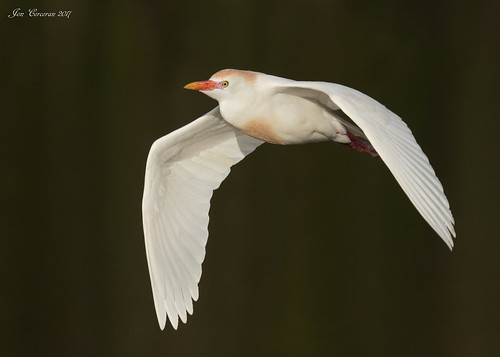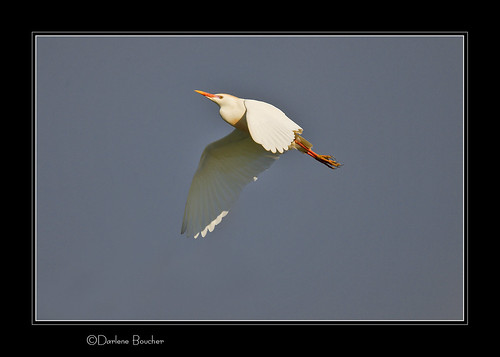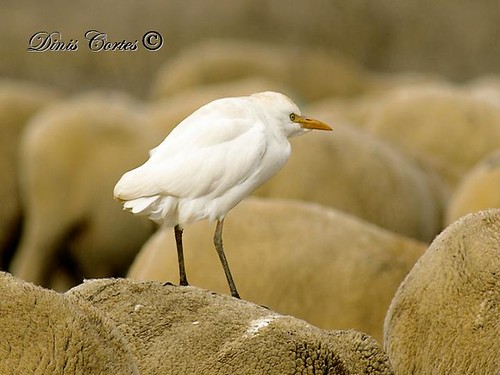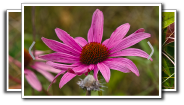Cattle Egret
(Bubulcus ibis)
Conservation • Description • Habitat • Ecology • Distribution • Taxonomy
Conservation Status |
|
|||||||
| IUCN Red List | LC - Least Concern |
|||||||
| NatureServe | N5B, N5N - Secure Breeding and Nonbreeding SNRB - Unranked Breeding |
|||||||
| Minnesota | not listed |
|||||||
Description |
||
The legs and bill are yellowish-orange. |
||
Size |
||
19″ to 21″ in length 36″ wingspan |
||
Voice |
||
Similar Species |
||
Habitat |
||
Marshes, agricultural fields |
||
Ecology |
||
Migration |
||
Spring and fall |
||
Nesting |
||
|
||
Food |
||
|
||
Distribution |
||||
Occurrence |
||||
Rare migrant, does not breed in Minnesota |
||||
Maps |
||||
The Minnesota Ornithologists’ Union All Seasons Species Occurrence Map |
||||
Taxonomy |
|||
| Class | Aves (birds) | ||
Order |
Pelecaniformes (pelicans, herons, ibises, and allies) | ||
Family |
Ardeidae (bitterns, egrets, herons) | ||
Subfamily |
Ardeinae (typical herons and egrets) | ||
Genus |
Bubulcus (cattle egrets) | ||
Subordinate Taxa |
|||
Eastern Cattle Egret (Bubulcus ibis coromandus) Seychelles Cattle Egret (Bubulcus ibis seychellarum) Western Cattle Egret (Bubulcus ibis ibis) |
|||
In 1988, McAllan and Bruce split the eastern and western races of Cattle Egret, reclassifying the former to the Bubulcus coromandus. Avibase - The World Bird Database accepts the split. Most other authorities do not. |
|||
Synonyms |
|||
Bubulcus ibis ibis |
|||
Visitor Photos |
|||||
Share your photo of this bird. |
|||||
| This button not working for you? Simply email us at info@MinnesotaSeasons.com. Attach one or more photos and, if you like, a caption. |
|||||
L Bergstrom |
|||||
Hung around approx 3 hours in our yard and neighbors. |
|||||
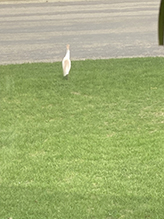 |
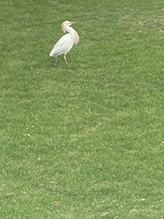 |
||||
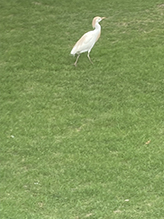 |
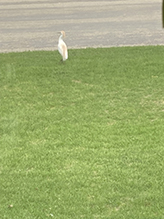 |
||||
MinnesotaSeasons.com Photos |
|||||
|
|||||

Visitor Videos |
|||
Share your video of this bird. |
|||
| This button not working for you? Simply email us at info@MinnesotaSeasons.com. Attach a video, a YouTube link, or a cloud storage link. |
|||
Avi Birds |
|||
| Cattle Egret [Bubulcus Ibis] Jan 11, 2023 |
|||
About
In this video, we learn about the cattle egret. |
|||
Other Videos |
|||
| Cattle Egrets with Cattles Menora James |
|||
About
Uploaded on Jul 8, 2011 The Egrets mostly followed the cattle. This I observed during my holidays. In this video you can see two egrets following a calf where ever he went. I think they are near them to eat the insects coming out of the grass when the cattle eat it. I really enjoyed observing how they behaved and waited patiently around the calf. A few captures I missed and they were hilarious. They never left the cattle and seem to be attracted by a magnetic force !! You can also see that they get on well with each otrher. ====================== The Cattle Egret is a cosmopolitan species of heron (family Ardeidae) found in the tropics, subtropics and warm temperate zones. It is the only member of the monotypic genus Bubulcus, although some authorities regard its two subspecies as full species, the Western Cattle Egret and the Eastern Cattle Egret.Originally native to parts of Asia, Africa and Europe. The bird is called a Cattle Egret because it is mostly seen with grazing cattle, stalking energetically alongside the animals , running around them and in between their legs, all for seizing insects that are disturbed by the movement of cattle. They spends most of its time in meadows or other open areas., Every day, the Cattle Egret flies to a cattle herd, and spends the day feeding on bugs, spiders and other small animals. A delicacy for the Egrets is locusts -- when locusts swarms appear in steppes and meadows, a lot of Cattle Egrets are sure to arrive, too. They also have no fear of humans. Birds that feed around cattle's feet get more insects than those that feed elsewhere. The birds also sometimes sit on the animal's back and look around for possible prey, or pick off ticks from its back. Cattle don't seem to mind the presence of Cattle Egrets. This species differs from other Egrets in both appearance and behaviour. The Cattle Egret looks for food in meadows, Breeds and roosts in trees usually close to freshwater. Feeds in shallow wetlands, especially rice-paddies, but may also feed in dry grasslands. These birds are medium-sized, reaching a length of 48-53 cm, with a wingspan of a little less than 1 meter.The bird has a short, muscular neck and when walking, the Egret looks clumsy, unlike the other Egret species that are always elegant and majestic. In winter, both the sexes appear almost identical, with a creamy plumage, while the females' tends to be a bit lighter. During the mating period, Cattle Egret males grow a spectacular yellowish-orange feathers on their heads, chest and back, while the beak becomes almost red. The males, who are usually quite passive, become very loud and aggressive. The male finds a secluded place and starts showing off by stretching the neck and wings. About 10 females observe the male for quite some time, and later the male can choose one of them to mate with. After copulation, the pair finds a place for nesting -- small trees, bushes or water plants. Both the parents incubate eggs, and the chicks hatch after 24 days. Thirty days after hatching, the young Egrets start flying, and in 15 more days they become completely independent, and having a life expectancy of about 13 years. Cattle Egrets live in flocks of up to 20 specimen. . In the evening the group comes together again and finds a place to drink. It's interesting that Cattle Egrets don't mind other bird colonies in their territory, and there can be up to 100 bird nests in a single tree. |
|||
| BTO Bird ID - Cattle Egret BTOvideo |
|||
About
Published on Dec 16, 2015 A white heron in the UK is likely to be a Little or Great White Egret. Occasionally Cattle Egrets turn up, and some even stay to breed. How can you pick one of these wanderers out? |
|||
| cattle egret Wim Spronk |
|||
About
Published on Jun 10, 2013 Strange behaviour of Cattle Egret. It moves its head from side to side with a strange movement of the neck. Could it be that it is gauging the distance to its prey?Like owls and shore birds do? But it does it while it is not hunting as well. |
|||
| Cattle Egret (Bubulcus ibis) HD Video Clip 1/1 Tim Siggs |
|||
About
Published on Aug 4, 2015 The cattle Egret is a very familiar bird of open country, especially as the name implies, where livestock exist. It is a widespread species in many other countries including Asia, Europe and Africa. In Winter, the plumage is totally White however, in breeding plumage, the head and neck becomes orange. The Cattle Egret breeds communally in dense colonies which are both noisy and smelly. These birds were filmed in the Lockyer Valley in South East Queensland. |
|||
| Cattle egret eating ticks Lynette Rudman |
|||
About
Published on Jun 30, 2016 Watch how this Western Cattle Egret pulls ticks off a cow that is resting and chewing her cud, by Lynette Rudman. |
|||

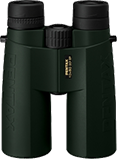
Last Updated:
